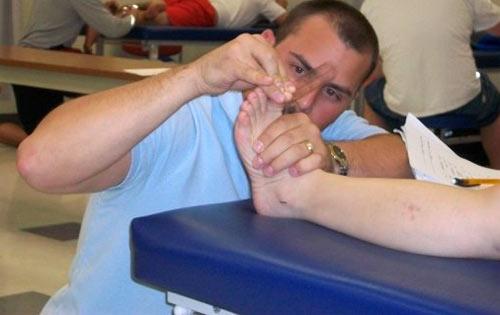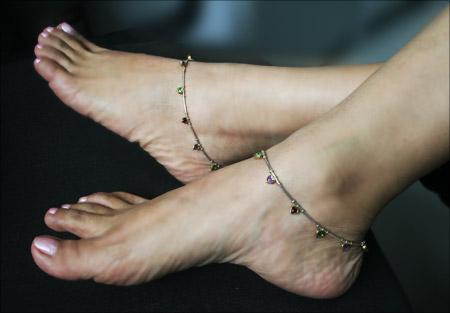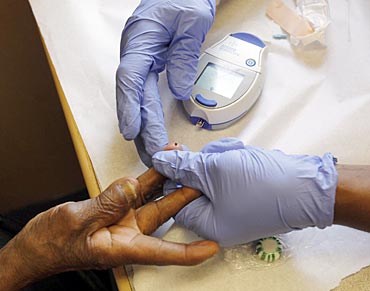Photographs: Wine france/Wikimedia Commons
Interventional diabetologist Dr Suresh Purohit from Mumbai tells us why diabetics must take extra care to protect their feet, specially in cold weather.
Diabetes can cause a number of serious health problems.
The most common one being nerve damage, which affects more than 50 percent of those with diabetes.
The fluctuating blood sugar levels in a diabetic patient causes damage to nerves and blood vessels in the body, resulting in loss of sensation, poor blood circulation, thereby leading to poor healing of foot ulcers.
While diabetes patients are advised to take care of their feet regularly, doing so in the winters becomes critical due to reduced blood flow and increased dryness.
For this reason, diabetics should pay close attention to their feet and take precautions to ensure that a minor cut does not lead to foot amputation.
"Inspection of feet is the most important aspect as far as diabetic foot care is concerned", says Dr. Suresh Purohit who has treated many chronic cases of diabetic foot with impending amputations.
Here is a check list by Dr Purohit to ensure your diabetic feet are safe.
Please click NEXT to continue reading...
Living with diabetes? Keep your feet healthy
Image: Applying a parafin based moisturiser to protect from fungal infectionPhotographs: Dominic Xavier/Rediff.com
Check your feet daily
Look carefully at all the pressure areas of your feet and between your toes. Check for blisters, open sores, cuts, colour changes, or ingrown toe nails.
If you have trouble seeing the bottom (sole) of your feet use a mirror and immediately report to doctor if you notice anything that looks abnormal.
Keep your feet soft
Apply paraffin based moisturiser on the top and bottom of your feet and avoid leaving too much moisturiser between your toes. Applying moisturiser between toes can make it prone to fungal infection.
Wash your feet in lukewarm water
Keep your feet clean by washing them daily. Take care to wash between the toes.
Wipe your feet with a clean towel and keep them dry. Do not use hot water.
Cut toe nails straight across
Don't cut nails too short, as this could lead to ingrown toe nails. Untrimmed or infected toenails are a frequent cause of fungal infections and ulcers.
You can also soak your feet first to soften the nails and then cut them straight across.
Do not remove corns and calluses
Thick patches of skin called corns or calluses can grow on the feet.
If your doctor tells you to, use a pumice stone to smooth corns and calluses after bathing or showering. Rub gently, only in one direction, to avoid tearing the skin.
Do not cut corns and calluses and do not use razor blades, corn plasters, or liquid corn and callus removers.
Medicated pads should be avoided. Immediately consult doctor for proper treatment.
Living with diabetes? Keep your feet healthy
Image: The socks you wear must be dry and fit wellPhotographs: Zara J/Wikimedia Commons
Wear clean, dry socks
Change daily into clean socks which must fit well. Tight elastic band socks should be avoided as they reduce blood circulation.
Always wear socks with your shoes, since leather, plastic, and manmade shoe material can irritate your skin and bring on blisters.
Wear comfortable shoes
During cold weather, wear diabetic shoes or other cold weather protection shoes. Before buying or putting on the shoes check your shoes for rough seams, sharp edges, pebbles, nails and any irritating objects that could hurt your feet.
Never walk barefoot
Protect your feet with shoes and socks at all times and in all places, including indoors. Protect your feet from hot and cold.
Keep the blood flowing to your feet
Put your feet up when you are sitting. Keep wiggling your toes for 2-3 minutes during the day.
Move your ankles up and down and in and out to help blood flow in your feet and legs.
Do not cross your legs for long periods of time. Poor circulation can also lead to increased swelling and dryness of the feet.
Cold weather exacerbates the problem by further reducing blood flow and by indirectly reducing exercise.
Living with diabetes? Keep your feet healthy
Image: Keep your blood sugar in checkPhotographs: Brian Snyder/Reuters
Test blood sugar
To keep your blood sugar level under control check it regularly preferably every alternate day and keep a record on your log book.
Your feet absorb a lot of the daily wear and tear of your body. They are one of the first places poor diabetic control will show up.
Keeping your diabetes under good control is an important part of diabetic foot care.
Living with diabetes? Keep your feet healthy
Image: Reduce the intake of tobacco to improve blood flowPhotographs: Eliseo Fernandez / Reuters
Quit smoking
Smoking reduces blood flow to your feet as it narrows the arteries.
Living with diabetes? Keep your feet healthy
Image: Light exercises every day will improve blood circulationPhotographs: Mike Baird/Wikimedia Commons
Avoid using hot water / heating pads
Heating pads burn the feet of a diabetic. Hence a one should avoid using them.
Be more active
Being active improves blood flow to the feet. Move more everyday by walking, dancing, swimming, or cycling.
Start slowly with light movement exercises if you are not very active. Consult your doctor or fitness expert for safe ways and limits.
Be in touch with your doctor
Have your feet checked by your doctor regularly to prevent foot gangrene and any other complications.
Tell your doctor about any changes in sensation in your toes, feet, or legs, even if it seems trivial to you.







Comment
article